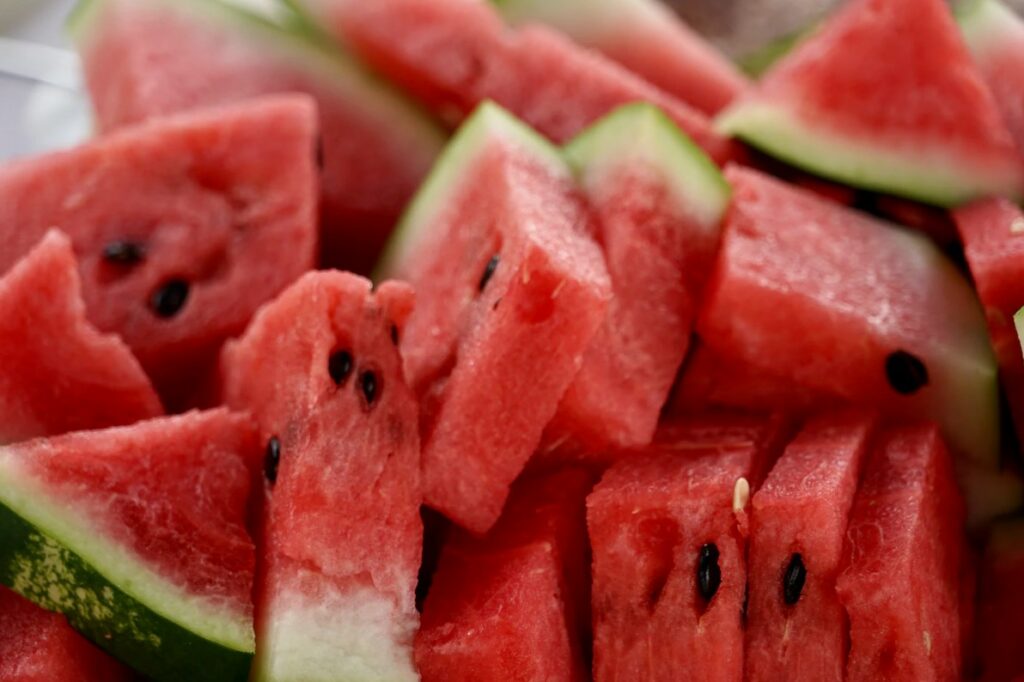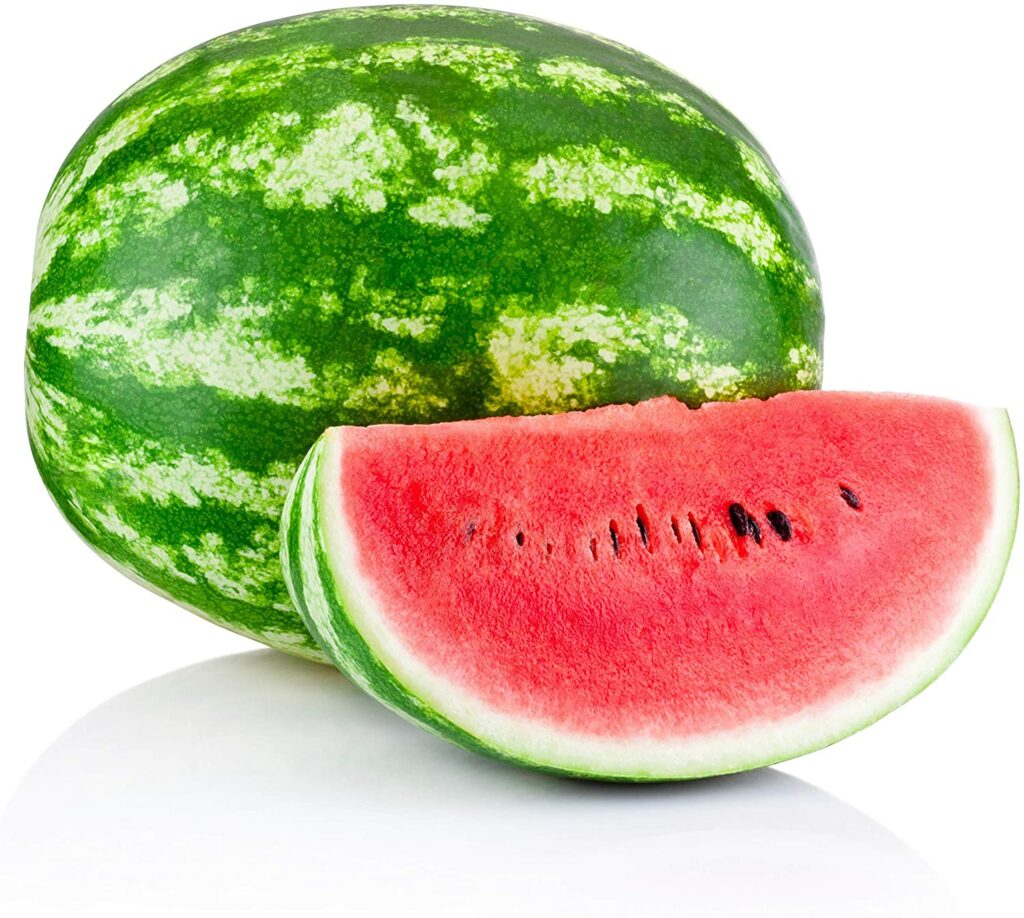- Best Blueberry Companion Plants That You Should Totally Plant Together - August 13, 2021
- Chandler Strawberry Growing Guide: How to DIY? - August 8, 2021
- Albion Strawberry Growing Guide: How to Enjoy This Fruit All Summer - July 5, 2021
Crimson Sweet is one of the more popular watermelon varieties. You know – the typical large, oblong melon with light green and dark green stripes that you see in the supermarket. Yes, it is that one. The hefty Crimson Sweet watermelon can grow up to 25 pounds (11 kg). The inside is stunningly gorgeous with a deep red flesh – sweet and firm. This watermelon is best eaten fresh or in a fruit salad.
Nutritional Content
Before getting into the growing details, take a look at Crimson Sweet’s nutritional content. Knowing how nutritious this plant is may convince you that the effort of growing it is worthwhile.
Watermelon provides a healthy dose of immune-boosting vitamins C and A. Also, disease-fighting antioxidants. This sweet fruit also provides a bit of potassium, which is helpful to control blood pressure and possibly prevent strokes.
Red-fleshed watermelon is high in the potent antioxidant lycopene. This antioxidant has cancer-preventing properties. The yellow-fleshed variety is high in beta-carotene, which also has disease-fighting properties.
For more information on the healthy benefits of watermelon, check out livescience.com
A Little-Known History of the Watermelon

You may have fond memories of watermelons quenching your thirst on a hot summer day. Such unforgettable juicy sweetness! But you may not know the origins of this summer staple. Though these days, watermelon is available year-round.
Watermelon (Citrullus lanatus) is a flowering plant species belonging to the Cucurbitaceae family. Famous members of this vine-growing family include – gourds, squash, pumpkin, and cucumber.
Watermelon is native to tropical Africa. They were also domesticated in Africa. Archaeologists found at Twelfth Dynasty ancient Egyptian sites and in the tomb of the Pharaoh “King Tut.” Eventually, watermelons spread across to the European continent, where they flourished in the warmer Mediterranean area. Records from 1629 show that watermelons already found a place in Colonial America, specifically in Massachusetts. Since colonial days, watermelon remains an important commercial crop in the southern states.
Today, there are more than 1,000 varieties of watermelon cultivated around the world.
How to Plant Crimson Sweet Watermelon
If you plan to grow Crimson Sweet, keep in mind – it needs a king-sized garden bed. This sweet and immense beauty requires space, a long growing season to mature, plenty of warmth, and regular fertilizer. Overall, watermelons are extremely cold–sensitive. As such, they can only be grown as annuals in USDA zones 2 to 11.
Planning the Garden for Crimson Sweet Watermelon
Before planning the location, consider the planting time. Plant watermelon only after the soil is warm (62 degrees F or greater) and when there is no danger of frost. Remember, this plant is native to tropical Africa.
You need to plan the garden well before introducing Crimson Sweet. After all, they will take up plenty of space and remain in the garden for many months.
Soil Requirements
The University of Arkansas recommends that you plant watermelon in sandy loam soil because they warm faster in the spring and are easy to cultivate. Crimson Sweet enjoys light, well-drained soil with a pH of 6.5 to 7.5. Watermelon is sun-loving, so a southern exposure is ideal.
Sowing Seeds in Indoors
If you have a relatively short growing season, perhaps it is better to start your seeds indoors. Here are some tips on planting Crimson Sweet seeds indoors:
- Start indoors 3 to 4 weeks before the last frost.
- Sow seeds 1 inch deep in seed-starting formula.
- Sow 2-3 seeds per pot.
- Keep the soil moist and warm, around 70 degrees F.
- Seeds should germinate in 7 to 10 days. Once they emerge from the soil, give them plenty of light on a sunny windowsill. Or place beneath fluorescent plant lights for 16 hours per day.
- Thin to one per pot after their true leaves emerge. Before you put them in the garden, the seedlings will need a “hardening off” period. The hardening off process toughens the plant’s cell structure and reduces the risk of transplant shock. To do this, place them in a sheltered place outdoors for a week. But, make sure to protect them from wind or hot sun at first. Such conditions can kill young seedlings. If there is a chance of frost, cover or bring them indoors for the night.
Sowing Directly in the Garden
For gardeners with a longer growing season, you can sow Crimson Sweet seeds directly in the garden. Here are some valuable tips:
- Sow seeds in warm soil after all danger of frost is gone.
- Seeds germinate best in between 70 to 95 degrees F.
- Sow seeds 3 inches in groups of 4-6 on a raised mound. Cover with 1 inch of fine soil and pat it down lightly.
- Each mound should be 5 – 7 feet apart from the other.
- Ensure that the soil is evenly moist during the germination period.
- In warm conditions, seeds germinate in 7 to 10 days.
- Once the seedlings emerge, thin them 2 or 3 most robust seedlings in each group when they are about 1 to 2 inches tall.
How to Care for Crimson Sweet Watermelon

Light Requirements
Crimson Sweet needs full sun. That is more than 6 hours of direct sunlight each day. Less than that, they may produce inferior fruit or not at all.
Watering Requirements
Once the plants establish themselves in the soil, allow the surface soil to dry between watering—overwatering results in tasteless fruit and underwatering in dry fruit.
Fertilizing Requirements
Nitrogen in the soil promotes foliage growth which is essential for long healthy vines. Phosphorus is responsible for producing flowers that turn into fruit. Watermelons need a balanced ratio of nitrogen, phosphorus, and potassium in the soil. Choose a fertilizer that has a balanced ratio like a 10-10-10. Fertilize following the instructions on the container.
Row Covers
Watermelons need consistent warm conditions. Keeping the ground warm with plastic mulch and row covers helps to ensure earlier cops and better yield. These measures are instrumental in the northern United States and Canada, as their summers are not as long and hot. You can remove the covers when plants have female flowers. These are tiny fruit at the bottom of the blossom.
Days to Maturity and Harvesting
Crimson Sweet tends to mature 85 days after planting. Fruits will weigh between 25 to 35 pounds.
Figuring out if your Crimson Sweet watermelon is ripe tends to be a bit tricky. There are three ways to tell if the fruit is ripe:
- The tendril near where the fruit stem attaches to the vine is browning or dead.
- The spot where the fruit rests on the grown turns yellow.
- When you flick the watermelon with your fingers, and you hear a “punk” instead of a “pink” or “pank” sound.
- Also, watermelons start to get a dull look when fully ripe, the powdery or slick appearance on top disappears.
Where to get Crimson Sweet Seeds
As they are a popular variety of watermelon, Crimson Sweet seeds are very easy to find. You can get them in your local nursery, garden store, and online. Here are some reputable and popular online seed sellers with links to Crimson Sweet seeds.
Final Thoughts on Crimson Sweet Watermelon
If you have enough garden space and time, try to grow your own Crimson Sweet watermelon. It is easy to grow and offers superior-quality fruit – sweet, red, firm, and juicy.
Here is an idea – grow Crimson Sweet as a gardening project with children to introduce gardening. It will amaze them to see how tiny brown seeds transform into vines with extra-large fruits. As a treat for their efforts, the children will enjoy many mouthfuls of Crimson Sweet watermelon at the end of the summer.
FAQs
Answer: Bitter fruit may be due to hot and dry temperatures, too much watering, or poor soil fertilization. Tasteless watermelons are usually the product of the soil having too much water.
Answer: When this happens, the vine is getting too much nitrogen. Nitrogen helps create foliage, but the vine won’t flower and fruit without enough phosphorous in the soil. Choose a balanced fertilizer like a 10-10-10 to help with this.
Answer: Try not to allow the vine to produce more than 3 to 4 per plant. The more fruit a vine has to support, the smaller the fruit will be. Also, if there are too many fruits on a vine, they will take much longer to ripen.
Answer: This answer is simple – no. These watermelons are as ripe as they ever will be when you pick them off the vine.
Sources
- https://www.uaex.edu/publications/pdf/fsa-6012.pdf
https://www.burpeehomegardens.com/Vegetables/PlantDetails.aspx?plantid=5105
https://www.gardeningknowhow.com/edible/fruits/watermelon/growing-crimson-sweet-watermelons.htm - https://www.johnnyseeds.com/vegetables/watermelons/crimson-sweet-watermelon-seed-2133.html?cgid=watermelons
- https://www.gurneys.com/product/crimson_sweet_watermelon

